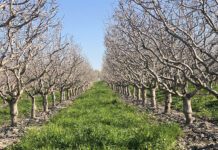
The good news for pistachio growers when it comes to anthracnose is the widely grown variety Kerman doesn’t appear susceptible to the disease. The bad news is the increasingly popular varieties Golden Hills and Lost Hills apparently are.
Still, with no anthracnose showing up in commercial orchards planted to the two varieties in recent years, chances are the disease may fade into obscurity before ever becoming a threat.
Only one cultivar grown in California appears highly susceptible to the disease, Red Aleppo, according to researchers who are studying the disease, and only a handful of growers produce it.
Common in almonds, anthracnose has a spotty history in the state’s pistachio industry dating to 1998 when it was found following a wet spring in mid-July in a Glenn County orchard and then in early September in a Tulare County orchard planted to Kerman. Occasional sightings of anthracnose in pistachios occurred over the next 18 years until in 2016 a Glenn County orchard planted to Red Aleppo showed severe symptoms.
Cultivar Susceptibility
The 2016 discovery raised red flags among researchers who were familiar with the damage the disease had inflicted on pistachios elsewhere. In 2010 in Australia, for example, the disease caused yield losses in excess of 50% to a cousin of the Red Aleppo cultivar after a rainy spring and summer, according to UC Davis plant pathologists Themis Michailides and Paulo Lichtemberg. The disease also has caused significant yield losses in China’s pistachio crop, the two said.
In a 2017 article in Progressive Crop Consultant, four researchers, including Michailides and Lichtemberg, wrote that the disease didn’t appear to be an immediate threat to pistachios but it was worth keeping an eye on. At one point, they noted, Botryosphaeria also wasn’t considered a threat.
“Botryosphaeria panicle and shoot blight started in a pistachio orchard in northern California, and in about 12 years, the disease became a devastating epidemic in pistachio throughout the state,” the researchers wrote.
After the 2016 discovery, the researchers launched fungicide trials in a commercial orchard planted to Red Aleppo and at the UC Kearney Research and Extension Center in Parlier to research control measures. And they began surveying pistachio orchards in different regions of the state for the presence of the disease. Four years later, with anthracnose still not causing significant damage outside of the Red Aleppo cultivar, the researchers may be nearing the end of their work on the disease, or at least approaching a moratorium on it.
California’s dry climate, Michailides said, and the fact that so much of the state’s acreage is planted to Kerman appears to be playing in the state’s favor. And the fact that the disease hasn’t spread into commercial plantings of Golden Hills and Lost Hills, both of which have suffered yield loss when inoculated with the anthracnose fungus in trials, is significant.
Still, Michailides and Lichtemberg aren’t ready to declare the disease a non-threat to the California pistachio industry. “It could be a problem in the future under the right conditions, now that so many Golden Hills and Lost Hills are going in,” Michailides said.
Sunken Lesions
Anthracnose symptoms are similar to Botryosphaeria symptoms, the main difference being anthracnose doesn’t cause shoot blight and, unlike Botryosphaeria, its lesion on fruit is sunken and usually covered with pinkish sporulation. In addition, Lichtemberg said, at high infection rates, nuts blighted from anthracnose will detach from shoots after high winds and can be found on orchard floors. On leaves, anthracnose appears as circular lesions.
In surveys of pistachio orchards in California, the only incidences researchers have found of the disease is in the northern production regions.
Lichtemberg postulated several reasons for why the disease has yet to become a problem in the thousands of acres now planted to Golden Hills and Lost Hills, including that spray programs used to control Botryosphaeria panicle and shoot blight and Alternaria late blight are suppressing the anthracnose fungus, Colletotrichum fioriniae. Also, he said, it could be that the disease’s inoculum is so sparse, it hasn’t yet taken a foothold in orchards planted to Lost Hills and Golden Hills.
“It is a new disease and fortunately its inoculum is not widespread,” Lichtemberg said.
Researchers are confident in Kerman’s tolerance to the disease, given that in several cases, Kerman nuts were unharmed despite growing adjacent to Red Aleppo orchards that suffered heavy yield losses to anthracnose. Also, when Kerman is inoculated in the fungicide trials at the UC Kearney Research and Extension Center, it shows only mild symptoms and no apparent yield loss.
“So far, we have demonstrated that Kerman is safe,” Lichtemberg said.
Researchers are equally certain that Red Aleppo is highly susceptible to the disease.
“Some Red Aleppo orchards we visited last season (in 2019) had 100% incidence,” Lichtemberg said. “There was one grower who destroyed the whole crop because he could not commercialize it.”
Fungicides Ineffective
If the disease ever does become a problem in Golden Hills and Lost Hills, further research will be needed to devise control strategies, given that in four years of trials, Michailides and Lichtemberg have yet to find a product that can control the disease.
“We tried several products last year, for example,” Lichtemberg said, “and 100% of our clusters were infected. We could not control it.”
In the research center trials, beginning in mid-April, researchers applied four treatments at monthly intervals of a variety of fungicides registered in pistachios, including SDHI, DMI and QoI fungicides, and none controlled the disease. Fungicide trials conducted in a commercial orchard planted to Red Aleppo in Glenn County also provided no positive results.
The researchers are unsure why the fungicides have failed. It could be the result of resistant strains, improper spray timing or a combination of factors, they said.
Michailides said further studies into the disease’s life cycle could provide information that will help pinpoint better control strategies.
“We need to define the life cycle of this, how it develops, how it overwinters, and then we can design more appropriate management approaches,” Michailides said. “For instance, if we find that it overwinters in the bud, perhaps a dormant spray will help.”
Any further research into the disease, however, is in danger of being discontinued. With the disease not appearing to be an issue in commercial plantings outside of the Red Aleppo cultivar, incentives to study it are minimal, Michailides said. And the owner of the Glenn County orchard that the researchers are using for their fungicide trials has told Michailides and Lichtemberg that he plans to pull out his orchard unless they can devise a means to control the disease, a development that will severely hamper the researchers’ ability to study it.
“That will make it difficult to study the disease in a commercial setting, and our orchards (at the Kearney Agricultural Research and Extension Center) aren’t large enough to do a good-sized trial,” Lichtemberg said.
At this point, if the grower decides to pull out his orchard, research may devolve into studying isolates in a lab that researchers have collected from the orchard to try and uncover why fungicides aren’t working, Lichtemberg said.
















